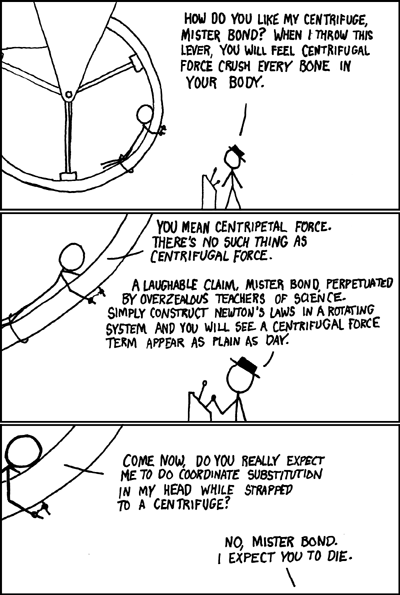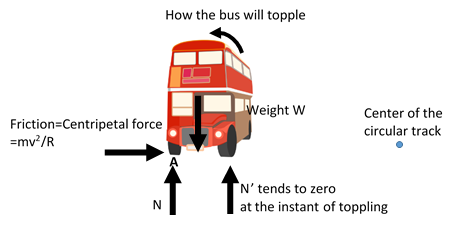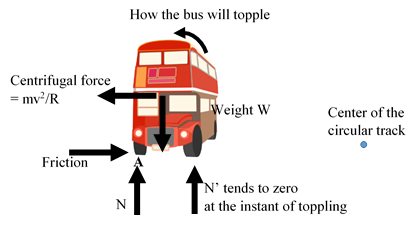Turn Safely
A double-decker bus wants to take a turn safely, without tipping over. Which of the following will decrease the chance of the bus toppling?
This section requires Javascript.
You are seeing this because something didn't load right. We suggest you, (a) try
refreshing the page, (b) enabling javascript if it is disabled on your browser and,
finally, (c)
loading the
non-javascript version of this page
. We're sorry about the hassle.
3 solutions
Much more complete solution!:)
When moving in a circle, the resultant centripetal force is F = r m v 2 .
If we increase the turning radius, r , but keep the speed constant, we have decreased the centripetal force, giving the bus less chance of toppling.
It is worth noting that moving passengers to the top deck would heighten the centre of mass, making the bus less stable.
Increasing the speed with constant radius would increase the centripetal force, making the bus more likely to tip.
Keeping the time constant but increasing the radius would give the bus more distance to cover in the same amount of time. Thus, the speed and the centripetal force would increase.
I think there is still some gaps in your explanation as of why increasing the centripetal force increases the chances of tipping? It is counter intuitive as the centripetal force is radially inward whereas the bus will topple radially outwards.
Log in to reply
Yes of course! I did leave that mostly to the reader... the centripetal force must be provided by the bus in order to maintain circular motion. If we decrease the force, the bus must provide less and so is more stable.
Log in to reply
I think it is not the bus that is providing the centripetal force rather the bus needs it and the ground applies a friction force which eventually acts as a centripetal force.
This friction force creates a torque to turn the bus and which is opposed by the torque of gravity (about the tires on which the bus will topple). The greater centripetal force will require greater friction which may cause the bus to topple side ways.
Log in to reply
@Rohit Gupta – Yeah, I said bus because the friction is also a result of its tyres.
Log in to reply
@Dan Ley – Yes, I was just highlighting the point that we are concerned about the friction that acts on the tyres and not the friction that the tyres apply on the ground. Although, their magnitudes are equal but directions are opposite.
Similar thinking
If the bus moves fast then as the centre of gravity (COG) of a double decker bus is situated quite above the ground so on slight sifting of COG from the middle vertical axis it generates enough torque to turn over the bus.This is also because of pseudo which helps in shifting of COG as it always acts away from the direction of motion.If passengers are more at top the COG is shifted further up which provides greater stability.But in 2nd case the bus moves at constant speed so there is no pseudo force as acceleration is 0
I disagree. If the bus is moving around a corner, there is centripetal acceleration. The second case provides the least amount of this acceleration.
Log in to reply
Yes, the bus will feel a centrifugal force, radially outwards, which is equal to R m v 2 . Therefore, if the radius of turning is increased keeping the speed constant, centrifugal force will decrease. This will decrease the chances of the toppling of the bus.
Log in to reply
I'm a Physics major. :) Saying "centrifugal" makes me cringe! Haha!
Log in to reply
@Michael Petro – The centrifugal force is perfectly valid if you consider a rotating frame.
 xkcd 123
xkcd 123
@Michael Petro – Why is it so? Don't you think there will be centripetal force experienced by the people inside the bus or the bus itself? The torque of this force will tip it radially outwards.
We can definitely explain the situation by the help of centripetal force as well but I find it easier with centrifugal force.
I don't completely follow this.
First, moving the passengers up will elevate the center of gravity, which is well known to increase turnover risk. Ditto for increasing the speed. That leaves us with increasing the turning radius, either at the same speed or "the same time", which means at a faster speed.
Log in to reply
You are correct. If we increase the turning radius by keeping the time same. Then angular velocity ( ω ) will be same. The formula for centrifugal force will be m ω 2 R . Hence, increasing the turning radius while keeping the time/angular velocity same will increase the chances of turning of the bus.
Is it only me, or by keeping time constant (as far as i am concerned, constant means it doesnt change) just freezes time and bus just cant fucking flip :D
This problem can be solved by either using the ground frame or the bus frame.
Suppose we're looking at the ground frame ,
When the bus goes in a circular path, the friction acts towards the center and provides the necessary centripetal acceleration. Thus, the friction is f = R m v 2 = m ω 2 R . This friction has a tendency of toppling the bus in the counter-clockwise direction as shown in the diagram above.
If the speed of the bus is increased keeping the radius of the turn constant, the requirement of the centripetal force and hence the friction will increase. This will increase the chance of tipping.
If the time it takes to make the turn remains constant then the angular velocity also remains constant. Now, if the turning radius is increased then again the requirement of the centripetal force and hence the friction will increase. This will increase the chance of tipping.
If all the passengers sit on the upper deck, the center of mass of the bus will be higher and the same friction will create a greater turning moment. This will increase the chance of tipping.
Lastly, if the turning radius is increased and the speed remains constant then by the formula f = R m v 2 , the friction decreases and hence the chance of toppling is decreased .
Now, suppose we are looking at the bus frame ,
In the bus frame, a pseudo force acts radially outwards on the center of mass of the bus. This is known as the centrifugal force. Now, the torque of the friction and the normal reaction are both zeroes about an axis passing through A and going along the length of the bus. The torque of the centrifugal force and the weight of the bus are in opposite directions. The torque of the centrifugal force tries to topple the bus whereas the torque the weight of the bus stabilizes it. The factors that will increase the torque due to the centrifugal force will increase its chances toppling. Thus, if the speed remains constant, but the turning radius was increased, then the chance of tipping will be decreased.